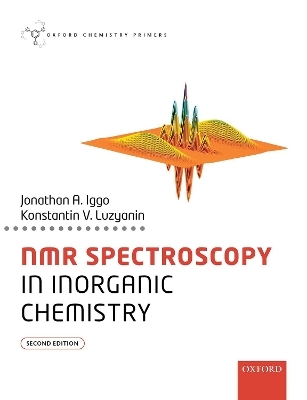
NMR Spectroscopy in Inorganic Chemistry
Seiten
2020
|
2nd Revised edition
Oxford University Press (Verlag)
978-0-19-879485-1 (ISBN)
Oxford University Press (Verlag)
978-0-19-879485-1 (ISBN)
NMR Spectroscopy in Inorganic Chemistry offers a non-mathematical grounding in the physics of NMR spectroscopy and explores why the spectra look the way they do, providing a useful collection of NMR examples and trends in NMR parameters from inorganic chemistry.
The renowned Oxford Chemistry Primers series, which provides focused introductions to a range of important topics in chemistry, has been refreshed and updated to suit the needs of today's students, lecturers, and postgraduate researchers. The rigorous, yet accessible, treatment of each subject area is ideal for those wanting a primer in a given topic to prepare them for more advanced study or research. Moreover, cutting-edge examples and applications throughout the texts show the relevance of the chemistry being described to current research and industry.
This new edition of NMR Spectroscopy in Inorganic Chemistry has been extensively updated to include worked examples, problems, self-test questions, and interactive online questions encouraging active learning and promoting a deeper understanding. With a concise and accessible introduction to predicting NMR spectra and expanded sections on quadrupolar nuclei, this excellent introductory text will help students get to grips with the basics before building on that understanding through diagrammatic content to explain the more challenging concepts.
Examples are included from many different areas of inorganic chemistry which are then closely related to the theory described. By giving a simple overview of the relevant theory and avoiding the 'pattern recognition' approach frequently used, it demystifies NMR.
The renowned Oxford Chemistry Primers series, which provides focused introductions to a range of important topics in chemistry, has been refreshed and updated to suit the needs of today's students, lecturers, and postgraduate researchers. The rigorous, yet accessible, treatment of each subject area is ideal for those wanting a primer in a given topic to prepare them for more advanced study or research. Moreover, cutting-edge examples and applications throughout the texts show the relevance of the chemistry being described to current research and industry.
This new edition of NMR Spectroscopy in Inorganic Chemistry has been extensively updated to include worked examples, problems, self-test questions, and interactive online questions encouraging active learning and promoting a deeper understanding. With a concise and accessible introduction to predicting NMR spectra and expanded sections on quadrupolar nuclei, this excellent introductory text will help students get to grips with the basics before building on that understanding through diagrammatic content to explain the more challenging concepts.
Examples are included from many different areas of inorganic chemistry which are then closely related to the theory described. By giving a simple overview of the relevant theory and avoiding the 'pattern recognition' approach frequently used, it demystifies NMR.
Jonathan A. Iggo is Lecturer in Inorganic Chemistry at the University of Liverpool. Dr. Konstantin Luzyanin is Lecturer in Inorganic Chemistry at the University of Liverpool.
1: Fundamentals
2: Structure determination
3: Factors influencing the chemical shift and coupling constants
4: Experimental methods: pulses, the vector model and relaxation
5: Polarization transfer and 2D NMR spectroscopy
6: Dynamic NMR spectroscopy
7: The solid state
| Erscheinungsdatum | 03.01.2020 |
|---|---|
| Reihe/Serie | Oxford Chemistry Primers |
| Verlagsort | Oxford |
| Sprache | englisch |
| Maße | 190 x 245 mm |
| Gewicht | 254 g |
| Themenwelt | Naturwissenschaften ► Chemie ► Anorganische Chemie |
| ISBN-10 | 0-19-879485-1 / 0198794851 |
| ISBN-13 | 978-0-19-879485-1 / 9780198794851 |
| Zustand | Neuware |
| Haben Sie eine Frage zum Produkt? |
Mehr entdecken
aus dem Bereich
aus dem Bereich


